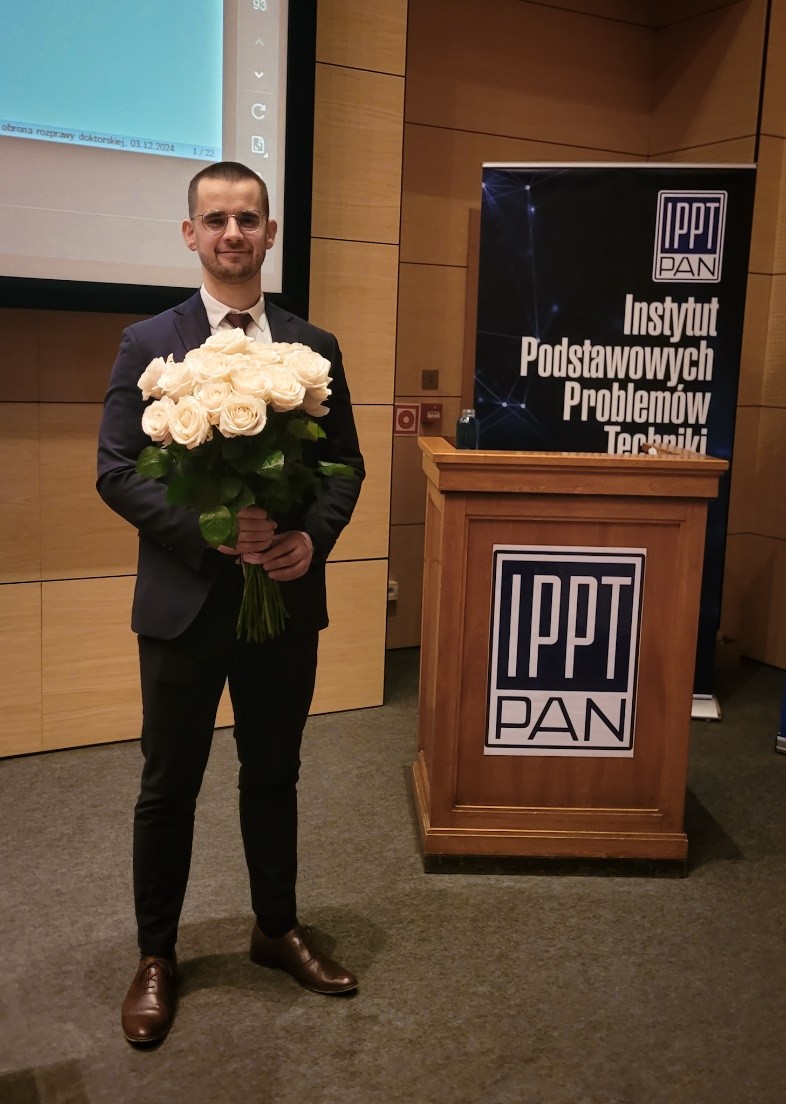
On December 12, 2024, according to the resolution of the Scientific Council of IPPT PAN, Jędrzej Dobrzański was awarded the degree of Doctor of Science in the field of Engineering and Technical Sciences in the discipline of Mechanical Engineering.
The doctoral dissertation is titled: „Finite-element modelling of moving weak discontinuities using laminated microstructures”.
A new computational approach for modelling material and moving weak discontinuities (referred to as interfaces) is presented in this thesis. The modelling of moving interfaces, both from a theoretical and numerical point of view, has been a subject of research for many years, leading to various models and computational methods to be found in the literature. One of such technique is the well-established phase-field method (PFM). Since this approach is not without weaknesses, one of the main aims of this dissertation is to address its limitations and compare it with a new proposed method.
In the new computational approach, which is based on the finite element method, the non-conforming mesh is used. It means that the spatial discretization of the computational domain is not compatible with the internal geometry of the modelled body, indicating that the nodes of finite elements do not lie on the weak discontinuities. As a result, an appropriate treatment must be applied to elements cut by the interface to account for the presence of two material phases with typically different parameters. In the proposed method, these elements are replaced by so-called laminated elements which are entirely composed of laminated microstructures with the volume fraction of both phases and the lamination orientation determined by the interface position within the finite element. Hence the name of the method - laminated element technique (LET).
The performance of LET is demonstrated through numerical simulations of problems typical for solid mechanics. The examples include both two- and three-dimensional problems, involving linear elasticity as well as elasto-plastic cases within finite deformations. Where possible, results obtained using LET have been compared with those from other methods, including analytical solutions, as well as results found in the literature. The obtained results confirm that LET is not able to achieve an optimal convergence rate (with mesh refinement) characteristic of finite-element modelling using conforming meshes. However, the results also demonstrate that LET can continuously respond to the continuous change in the interface position within a single finite element, providing a direct basis for generalizing this method to cases involving moving interfaces.
The generalization of LET to problems involving moving interfaces became feasible through its coupling with the phase-field method. The resulting computational technique, named LET-PF, exploits the advantages of PFM while simultaneously reducing some of its limitations. In contrast to PFM, in LET-PF phases of both materials are mixed within a thin layer of only one-element thickness. This allows for obtaining results of higher accuracy compared to the conventional PFM or results of comparable accuracy but using coarser meshes, thus reducing the computational cost.
The performance of LET-PF is demonstrated through problems typical for micromechanics of heterogeneous materials. These examples are limited to two-dimensional cases within linear elasticity. Results obtained using LET-PF have been subjected to an extensive comparative analysis, where they have been confronted with results from PFM and, if possible, with analytical solutions. This comparison leads to the conclusion that, in certain cases, LET-PF eliminates limitations of the conventional phase-field method, thus providing a significant advantage. Consequently, one of the main objectives of the dissertation has been achieved.















